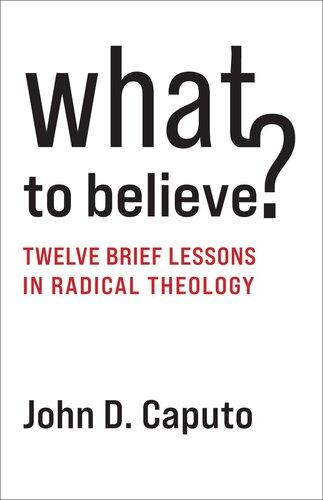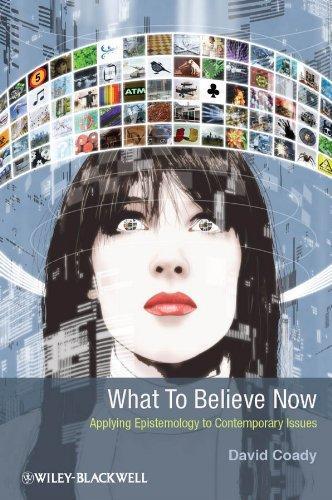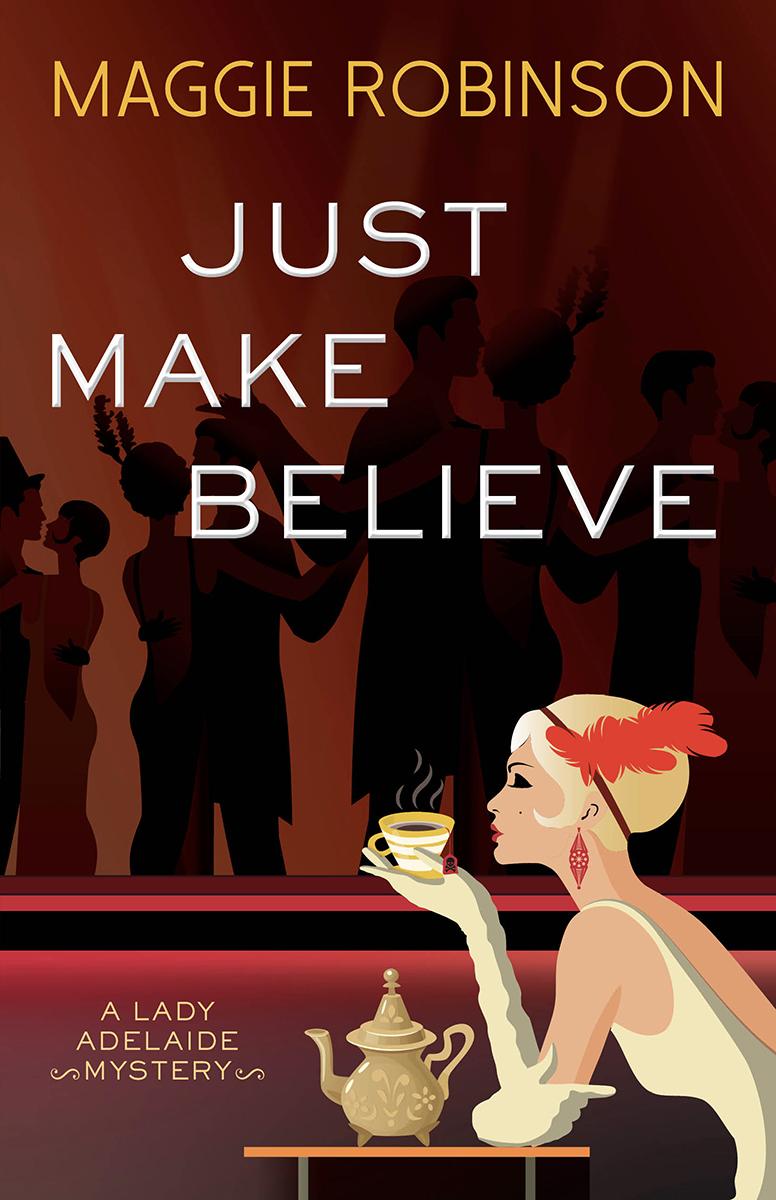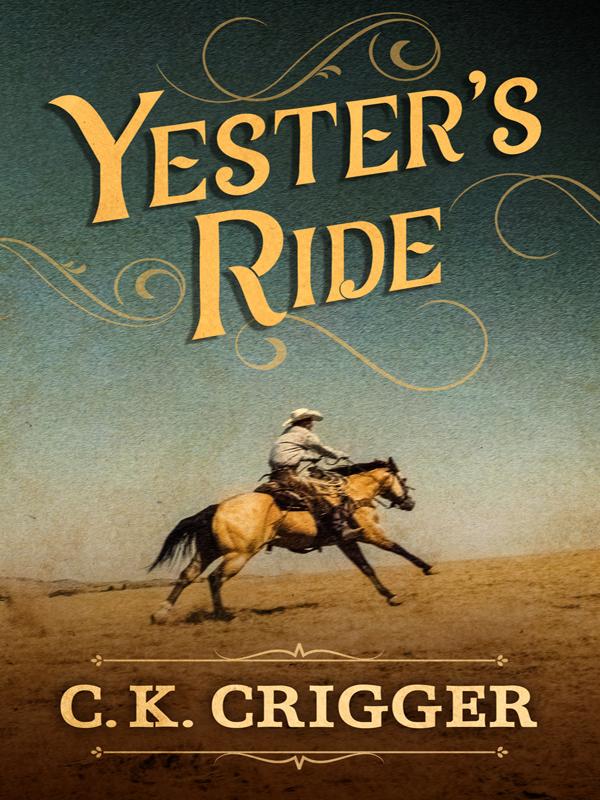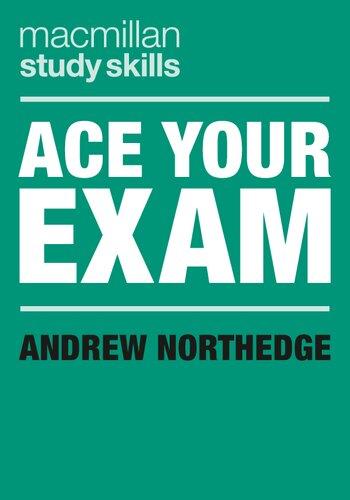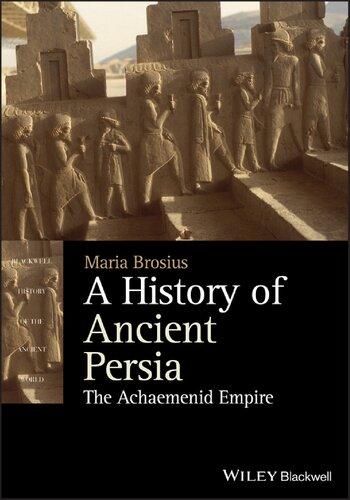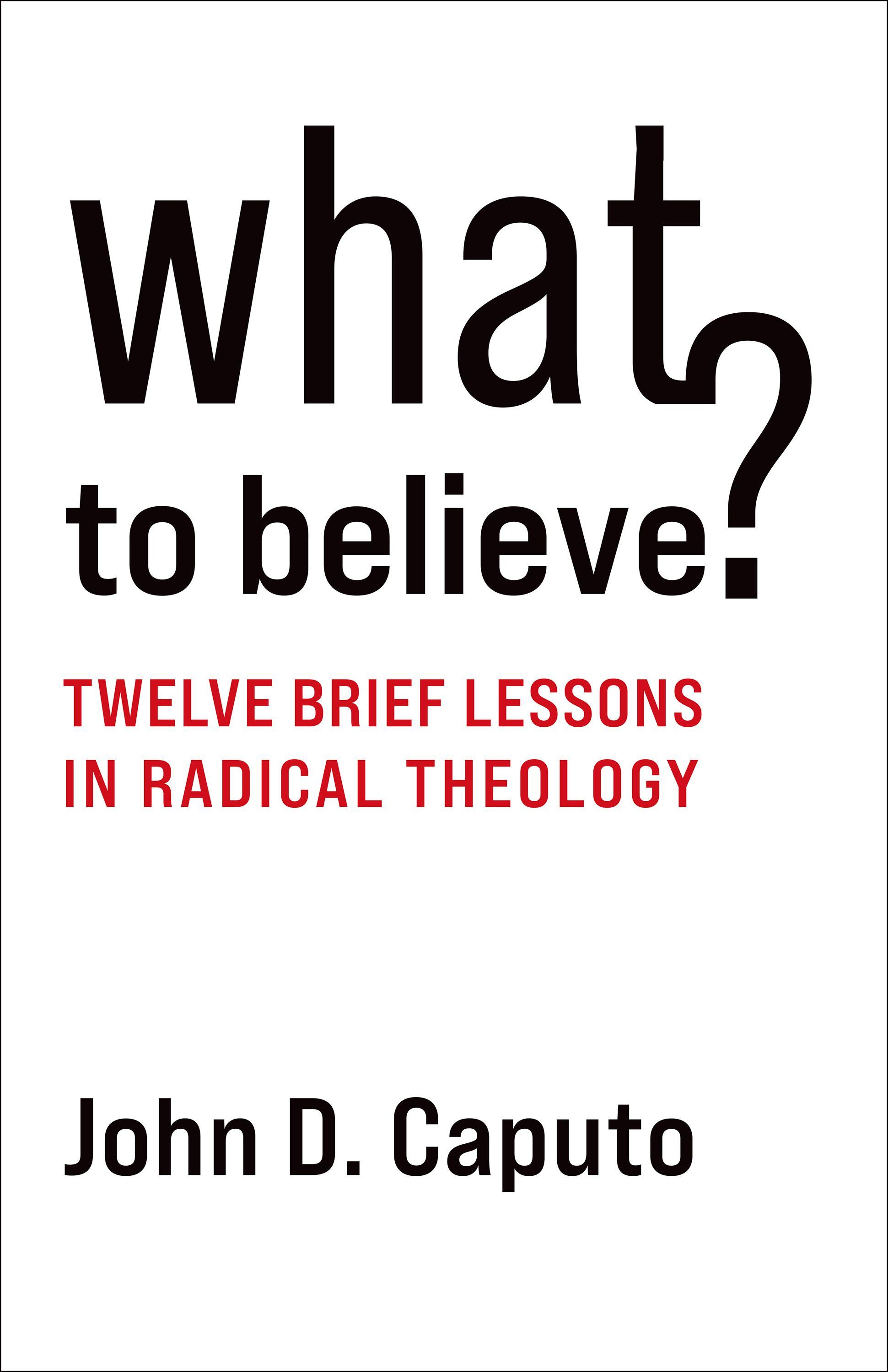WHAT TO BELIEVE?
Twelve Brief Lessons in Radical Theology
JOHN D. CAPUTO
Columbia University Press
New York
Columbia University Press
Publishers Since 1893
New York Chichester, West Sussex cup columbia edu
Copyright © 2023 Columbia University Press
All rights reserved
Library of Congress Cataloging-in-Publication Data
Names: Caputo, John D., author.
Title: What to believe? : twelve brief lessons in radical theology / John D. Caputo.
Description: New York : Columbia University Press, [2023] | Includes bibliographical references and index.
Identifiers: LCCN 2023000870 (print) | LCCN 2023000871 (ebook) | ISBN 9780231210942 (hardback) | ISBN 9780231210959 (trade paperback) | ISBN 9780231558662 (ebook)
Subjects: LCSH: Theism. | Divergent thinking. | Faith. | Belief and doubt. | Panentheism.
Classification: LCC BD555 .C26 2023 (print) | LCC BD555 (ebook) | DDC 230—dc23/eng/20230501
LC record available at https://lccn.loc.gov/2023000870
LC ebook record available at https://lccn.loc.gov/2023000871
Columbia University Press books are printed on permanent and durable acid-free paper.
Printed in the United States of America
To Nicholas J. Aversa (1932–1993), known to me as Brother Declan Paul, FSC, who made all the difference, and to a band of brothers for our lifelong bond.
First Week
CONTENTS
Acknowledgments ix
This Is How the World Began xi
Lesson One God Does Not Exist 3
Lesson Two Bridge-Builders and Ground-Diggers 15
Lesson Three That’s Pantheism, That’s Horrible! 33
Lesson Four Do Radical Theologians Pray? 43
Lesson Five The Mystical Sense of Life 57
Lesson Six Who Do They Say Jesus Is? 77
Second Week
Lesson Seven Suppose Everything Just Vanished? 97
Lesson Eight What Is Really Going On? 111
Lesson Nine What Is Going On in the Name of God? 127
Lesson Ten Whether God Will Have Been 143
Lesson Eleven Making Ourselves Worthy of What Is Happening to Us 151
Lesson Twelve So What? 165
A Parting Word (or Two): Yes, Yes 173
Further Reading 177 Index 183
ACKNOWLEDGMENTS
MY THANKS to Wendy Lochner and her staff who oversaw the production and publication of this book with dispatch and efficiency, and to the two readers who made several important suggestions for improving it. I also want to thank Joseph Bessler, Marianne Borg, and Robin Meyers— fellow travelers on the path of saving God from religion, as Robin puts it—who gave me invaluable advice and support in the preparation of this book. Finally, I owe more than I can say to a band of brothers, Fr. Robert Albright; John Broderick; Bernard Freiland; Bro. Joseph Mahon, FSC; and Andy Thompson, for their good counsel on this book and for a lifelong friendship. This book grew out of a short article I published— “Panentheism and the Weakening of God,” Modern Believing 63, no. 2 (2022): 141–47—which explains occassional overlapping phrasings.
THIS IS HOW THE WORLD BEGAN
I CANNOT remember anything older than God, anything in childhood that happened without God, anything older than being Catholic. I cannot remember God without Latin, or Latin without God. Latin was the sacred language, the one spoken to God and by God, or so I thought. Latin, like God, was eternal and omnipresent. As an altar boy I had mastered the faux phonic Latin mimeographed handout—Ahhd day-um kwi lay-teefee-kaht—that contained the responses to the priest we made at the foot of the altar. We answered for the people who, though perfectly capable of speaking their God-given English, were rendered mute by the Latin. So they followed along in their missals, which had the Latin in the left column, in a Gothic font, which lent it a mysterious, intimidating, otherworldly look, and the English, our earthly language, in the right. Or they quietly said their rosaries, trying to avoid drifting into distraction, whiling away an hour while Latin hummed in the background
like the traffic outside the church doors. But it never occurred to any of us to object that anything was out of order. Ad Deum, qui laetificat juventutem meam, “to God who gives joy to my youth.” Which God did. We were Catholic. Were we ever! Just about everybody I knew was Catholic—the whole world, my whole world. We were not merely Christian, a pale, bleachedout word that included Protestants, but Catholic, the one, holy, catholic, and apostolic Church, the Church, nineteen hundred and fifty years old and counting, an “apostolic succession” that stretched in a straight and unbroken line from St. Peter to southwest Philadelphia!
This is how the world began. Full of candles and incense, black cassocks and white surplices, priests and nuns, Gothic fonts and May processions, a dark picture of Jesus’s Agony in the Garden in the living room, going to confession on Saturday afternoon and Mass on Sunday morning, in our best clothes, followed by a large midday Italian meal and a lazy afternoon, all the stores being closed. That was the 1940s, the world of pre–Vatican II Catholicism, a spiritual world that, however considerable the changes in the material world around it, had remained unchanged for the last four hundred years. It was as frozen as the Latin language in which it was cast, ever since the Council of Trent (1545–1563) created what we all just called the Church, Holy Mother, the Church. I had never heard of Trent. 1545? 1945? What difference does it make? I just thought it was the eternal truth that had dropped from the sky, beginning with the day Jesus ordained Peter as his first pope. If I missed Mass on Sunday, which I never did, I would burn in hell for all eternity. Not a cruel and unusual punishment for a misspent
hour on earth, I thought, just getting what I deserved. Missing Mass was a “mortal” sin, which kills the soul, worse than killing the body, which was why they burned heretics back in the day. We did not fear violating the literal “word of God.” We feared missing Mass or violating “the teachings of the Church.” Either way, a real pope or a paper pope, infallibility or inerrancy, God, in Christian Gothic English, and a fair amount of fear and trembling were fellow travelers.
I have no recollection of ever seriously questioning any of this. In those days, having a question meant that if we asked “the priest” about the teachings of “the Church,” we would get “the answer”— all with a definite article—which he himself had learned in the large and intimidating seminary buildings about five miles from our mostly Irish Catholic neighborhood (we Italians were in the minority). I was ready to sign on the dotted line, and I did. I had originally planned to become a priest until I met the De La Salle Christian Brothers, who conducted the Catholic high school I attended in west Philadelphia. The nuns we had in grade school seemed to me celestial creatures, beyond or without gender, supramenstrual beings all covered up with veils that fluttered in the breeze as they made their way back and forth between the convent and the parish school. I found the Brothers engaging, personable, a human face of God. The Brothers called me Jack. The nuns called me John. That said it all. To this day, the difference between Jack and John for me is the difference between personal familiarity and an impersonal order into which I have been entered by powers beyond my control. The Brothers captured my heart. One Brother in particular, Brother Paul, got
me reading things on my own and told me I might be a good writer someday, if only I could correct my grammar (the Philadelphia accent was only improvable, not extinguishable). The nuns were hard-working women, some kind and loving, others a bit fierce, who, however heavenly their vocation, were not above corporeal punishment down here on earth. They ran the schools efficiently while getting pushed around by a patriarchal church. “The Pastor,” a tall, gray-haired, and imposing man, who genuinely scared me, settled all disputes. The nuns taught me to listen. The Brothers taught me to speak up. We need both.
I bring all this up so you will understand my beginnings, my point of departure, the point from which I started and also departed , as in, I beg to take my leave. This little book is not an autobiography, and it is by no means restricted to Catholics or Christians, rosary-bead-ardent, “recovering,” or somewhere in between. “Radical theology” is not confined to religion or even to belief in God; in fact, we might say that What to Believe? is a theology for people who do not believe in God, for “nones” and other seekers, who are seeking what they really do believe, feeling about in the dark for a deeper faith simmering under the swarm of beliefs and disbeliefs swirling overhead. Because religion is making itself increasingly unbelievable, radical theology seeks out what is believable, which makes for a religion without religion, a religion that is not the one you might be expecting. I am telling my story as a case in point, but I could make that point without ever mentioning religion or God. My wager is that others have an analogous story to tell, whatever their beginnings may be. Beginnings are embedded deep in our
bowels, our bones, our very being. The end is in the beginning, not as a destiny or deterministic fate, but as a set of possibilities whose outcomes can come as a surprise. Beginnings are like a keyboard on which we are invited to pick out a tune.
So the word radical in what follows does not signify a renegade attack, a bitter apostate railing against a cruel childhood— not a bit. Mine was a happily innocent and secure childhood, in a stable family. Sorry, no fearsome father or cold mother to report. I was grateful that I was not born a heretic like my Protestant neighbors (in the minority in our very Catholic bluecollar neighborhood). It was not at all a bad world to grow up in. Radical means rethought, restaged, reimagined, reinvented, all in an effort to get at what is really going on. So highlight this, it is a maxim to bear in mind: a radicalization is always the radicalization of something, something that was passed on to us, transmitted, something already up and running by the time we arrived on the scene, which is pretty much what tradition means. The radicalization of a religious tradition means to unearth what we can really believe in that tradition even if we no longer believe the official line they were selling us. There are, accordingly, as many radical theologies as there are traditions to radicalize. Radicals are traditionalists, and traditionalists have to be radicals if they want to take the process of transmission seriously, instead of using it as an alibi to cling to the past.
I am by training and inclination a lifelong academic, and I respect scholarly debate. So do not mistake what follows as a breezy twelve-step program in achieving wholeness! This might even leave you in pieces. But keep reading; do not let “academic” scare you off. As someone who has spent a lot of
time hanging out in academic conference hotel bars, I understand that technical language has its place, but I promise to keep it to a minimum here—to a minimum, but not to zero. Judiciously deployed, it can be quite helpful, which is why I do not hesitate to drop the names of several major philosophers and theologians. These are people with amazing imaginations and highly creative vocabularies, so it will not kill you to be exposed to some of the “big names,” which you in turn can drop at happy hour. Just as Carlo Rovelli highlights the most important ideas in contemporary physics while going light on the mathematics, I am trying to simplify without oversimplifying ideas that are too important to be kept under academic lock and key. What follows is neither a trek through a dense scholarly forest nor a visit to Mister Rogers’ Neighborhood. I imagine this little book as a daily lesson, six a week (we take the Sabbath off), over the course of two weeks. In the first week, we take up the first half of the argument: to talk you out of thinking of God as a Supreme Being (theism), who I claim does not exist, and to think instead of God as the “ground of being” (panentheism), which is a better bet. In the second week, we take the accent off being (ontology) and stress instead being’s worth (axiology), meaning what we love and affirm unconditionally. In so doing we can get at what we will call the event that is really going on in the name of God. This, I propose, is what to believe, what we really can and do believe, regardless of whether or not we “believe in God.”
That’s the royal road to radical theology, all of which I promise to explain and defend as we go along. So there is a logical argument that goes hand in hand with a historical development,
from theism (classical) to panentheism (modern), and then from panentheism to radical theology (contemporary). Keep an eye on both the story I am telling and the line of thinking I am selling. We do not have any ahistorical thoughts. This history explains how (actually) and why (ideally) theology got radicalized. Radical theology evolved; it was not shot from guns (in more sense than one).
My wager is that what follows will be useful to others who have never so much as met a priest, a nun, or a religious brother. I am sure the view of God I am setting out here would have shocked my parish priests and nuns. It certainly would have shocked young Jack, or John, or Brother Paul, the name I took when I made my “first vows,” after the other Brother Paul, who made all the difference in my life and the lives of many others.
FIRST WEEK
Lesson One
GOD DOES NOT EXIST
WE USED the old “Baltimore Catechism,” composed in 1885 at the direction of the Third Council of Baltimore, at the time the (all too Irish) Rome of American Catholicism. Maryland was named after the Catholic Queen Mary, wife of King Charles I, who granted a charter to Lord Calvert, the 2nd Lord Baltimore, in 1635. When I entered the Christian Brothers in 1958 after graduating high school, I found myself in the Baltimore District. The first school the Brothers established in the United States was called Calvert Hall, located a block away from the Baltimore Basilica, the first American Catholic cathedral. The Baltimore Catechism was a distillation of the Council of Trent into a compact little Q and A, which the nuns made us memorize and a lot of which I can still recite (the cover was green). The word catechism is related to the word echo; it literally means to drum something into the ear of someone who
can then echo it back. We got to be good at that. Lesson One began:
Q. Who made the world?
A. God made the world.
Q. Who is God?
A. God is the Creator of heaven and earth, and of all things.
Q. What is man?
A. Man is a creature composed of body and soul, and made to the image and likeness of God.
Q. Why did God make you?
A. God made me to know Him, to love Him, and to serve Him in this world, and to be happy with Him forever in the next.
This is a lot of information to get all at once, and it makes quite an impression on a seven-year-old. The implication was, of course (trust me, this was not left in doubt), that I would not be so happy in the next world if I did not get on board in this one. Who was I to argue with all that?
But if I were now asked “Who is God?,” safely out of the reach of my priests and nuns, I would say that God—that one, the God a lot of us grew up with, not just Catholics or Christians; the one that is out there in general circulation; the star of stage and screen; the Supreme Being, who sees all, knows all, can do all, who is watching every move we make and is coming to get us if we do not behave ourselves and to whom we turn when things take a turn for the worse—does not exist. The most
important thing we can say about God is that that God, God, does not exist.
However —keep reading, this is just as important—this does not spell the end of theology, but the beginning of a genuinely radical theology. It is not the end of the conversation, but the start of a new one.
I promise you that this is not a doom-and-gloom death-ofGod anything-goes nihilism. This is an atheism about the theism of the Supreme Being under whose constant protection and all-seeing surveillance I, like a lot of others, grew up with, but this— cover your ears—is a theological atheism. This atheism does theological service as the first step, not the last, on the way to a post-theistic radical theology or a/theology of what we really can believe.
I admit I am trying to be provocative, but this does not mean I am not serious. I am trying to get your attention, trying to get you to bite, on the bet that, if you bite, you will not be sorry. Back in Catholic grade school, this would have landed me in the office of the Mother Superior (on my way out the door). This is not the echo the nuns expected back. So think of this little book as a new revised version of the catechism, a primer in radical theology that never got an imprimatur. The Baltimore Catechism raised great questions for which I have ever since been grateful, like “Who is God?,” questions I have been asking myself all my life. It was delivered in daily lessons, which the nuns heard, which I am miming here by serving up twelve brief lessons in radical theology, in an attempt to save theology. This is a not a ruse, something passing itself off as theology while secretly trying to undermine it. Radical theology is
seriously theological, taking theology seriously. It is an attempt to make contact with something primal, prior to the wars between theism and atheism, religious and secular, prior to God. It is the theology of a kind of protoreligion, an audacious variant of the religion I grew up with, the one with all the candles and clergy.
These pages are addressed to everyone who eventually found God unbelievable and want to know what, if anything, is believable. Demographers tell us that the nones (meaning no religious affiliation) are waxing, and the nuns are waning. But none does not mean nothing, believing nothing at all. Nones no longer believe what they were told when they were growing up and now are trying to work out what they really do believe. The really do is what I mean by radical because it is what is really going on. (The italics here are flagging what this little book is all about.) The answer to their prayers, to our prayers, to my prayers— and I do believe in prayer (Lesson Four)—I propose, is radical theology, which begins by saying that Deus omnipotens, in Christian Gothic Latin, does not exist but what does exist may surprise you.
But the whole thing does not end there. It is just getting started.
This is not about trashing God. We did well together for a number of years. I was grateful for my “religious vocation.” When my children ask me what I was thinking about when I entered the religious life, taking lifelong vows of poverty, chastity, obedience, I smile and say they made me an offer I couldn’t refuse. The catechism said to “serve Him in this world, and to be happy with Him forever in the next”— a short temporal life
of sacrifice for an eternal life of happiness. That is just good economics. It turned out to be a step along the way of discerning my real religious vocation, what I really believe. I never renounced my deeper religious vows to something of elemental import, something deserving of my unconditional faith and allegiance, something really going on in the name of the name of God that saturated my youth. Highlight really going on every time you come across it: it cuts to the core of what I mean by radical , and I will take it up explicitly in Lesson Eight. I say “something,” meaning if only I could figure out what. He (indulge me for a moment) pursued me down the labyrinthine corridors of my life, and I am forever grateful for that. He—well, let’s say, He —stretched homogeneously and continuously from God the Father and His Son to the Holy Father (the pope), from his eminence the cardinal archbishop in a big office downtown to our pastor and parish priests, in a long apostolic line of unrelieved masculinity. Jesus said to call only God in heaven your father, but we called a lot of people Father. Nowadays we say She as much as we can. God is our mother, our father, our friend, our hope, our something. We need all the help we can get. Why tie one hand behind our back?
Thinking Radically. What I am calling radical theology means nothing more nor less than radical thinking. “Dare to think”— that is the motto of the eighteenth-century Enlightenment, which called itself the adulthood, the coming of age, of humankind. I am all for that. The more thinking the better.

